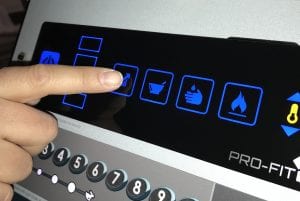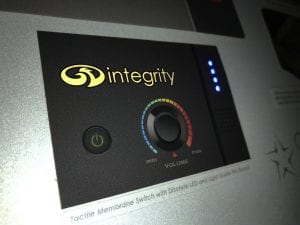 Membrane switches come with a number of advantages over traditional mechanical switches. As a membrane and labels manufacturer, we strive to educate our clients about the wide variety of uses our products have.
Membrane switches come with a number of advantages over traditional mechanical switches. As a membrane and labels manufacturer, we strive to educate our clients about the wide variety of uses our products have.
One of the biggest advantages of membrane switches is their thin, sleek profile – what some people don’t realize, however, is that despite their thin profile, membrane switches can still be backlit. In this article, we analyze the advantages of backlighting, its use cases, and some of the available backlighting techniques.
Backlit membrane switch use cases
Backlit membrane switches can be used in a wide variety of different applications. There are three principle use cases for backlighting: To highlight and distinguish between different elements of the membrane switch, to provide functionality in low and no-light scenarios, and to increase information density on the user interface (i.e. to provide users with more information using the same surface area).
Highlight important information
The information a manufacturer considers important will differ depending on the application of the device – it could be anything from the location of the on/off switch to highlighting the name of your brand. You know best what’s important to your end-users and your company.
Backlighting can make elements of your membrane switch stand out. This can be done by backlighting some elements of the switch (and not others), or by using contrasting colors to highlight one or two important elements (e.g. using an orange LED to highlight the on/off button on a membrane switch that’s otherwise backlit in orange).
Low-light and no-light functionality
Manufacturers can also use backlighting to illuminate the controls of their devices when they’re being used in low and no-light scenarios. This one is pretty self-explanatory – just think of how useful it is when remote controls light up in the dark. Low and no-light functionality is essential for devices that will be used outdoors at night, or in low lit environments such as server rooms where there may be no other light sources available.
Improved user interface
By toggling backlights on and off under certain circumstances, manufacturers can create more intuitive and informative user interfaces. The most classic example of this may be the use of a continuously illuminated “on/off” button when a unit is turned on or different colored LEDs for when the unit is on or off. LEDs can also be used to alert users of certain dangers – for example, you might see the use of LEDs to inform users that the surface of a stove is hot.
The advantages of backlit membrane switches

As we’ve just discussed, one of the primary advantages of backlit membrane switches is the diversity of different uses they have. The advantages don’t stop there, however – backlit membrane switches are cost-effective, can be used on all kinds of different devices in a wide variety of environments, and give your device an edge over the competition.
Low heat
Our backlit membrane switches generate almost no heat, as we use LEDs. This means they can be used even in heat-sensitive devices. The end-user won’t be able to feel the heat coming from the backlighting.
Low energy consumption
LED backlighting consumes next to no energy. LED backlighting can last for more than 100,000 hours – far longer than the expected lifespan of most devices the membrane switch will be placed on. The extremely low energy consumption of backlit membrane switches also means they will rarely (if ever) factor into the amount of power your device will need.
Low profile
Backlighting has almost no effect on the size of your membrane switch. General Label can build backlit membranes as thin as 0.041” in height. There are different orientations available for LEDs – we can help you choose the one that’s right for your membrane switch.
Cost-effective
LED backlighting is a low cost solution when compared to board level illumination. When you compare the price of backlighting to the functionality it provides, it’s often worth the extra cost. Additionally, given its low impact on the size and power requirements of your product, you can apply backlighting to almost any device.
Multiple colors
There is a wide array of color options available for backlighting.We incorporate single, bi-color, and tri-color top and side fired LED’s to build your perfect interface. The wide array of color options enables you to offer the end-user a better user interface, all while allowing you to express your brand.
Aesthetically pleasing
Backlighting looks good! It helps your product stand out from other products on the market. As we’ve discussed, the colors can be matched to your brand, and the profile of your membrane switch stays sleek – there’s a lot to like!
Membrane switch backlighting technology
There are a variety of technologies available which enable membrane switch backlighting. The technologies we employ in our membrane switches include LEDs and film light guides (FLGs).
LEDs
LEDs are the most commonly used lighting sources for membrane switches. They’re extremely long-lasting, they come in a wide variety of different colors, they offer several different levels of illumination, and they’re low cost. They can be used outdoors and indoors – versatility and quality are hallmarks of LED backlighting.
Film Light Guides (FLGs)
In early iterations of backlit membrane switches, producers encountered a problem: light would bleed from LEDs and illuminate parts of the membrane switch that weren’t meant to be illuminated. With the use of film light guides (FLGs), the LEDs in your membrane switch will only illuminate the areas you want them to, with no bleed.
Illuminate your product line
Interested in backlighting for your membrane switches? Get in touch with us. We’ll design backlit membrane switches for your product from the ground up, produce them for you, and test each switch individually for quality assurance. We’re General Label – and we’d love to work with you.